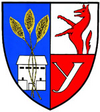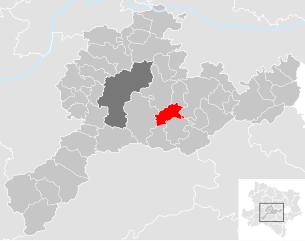Box near Böheimkirchen
|
Box near Böheimkirchen
|
||
|---|---|---|
| coat of arms | Austria map | |
|
|
||
| Basic data | ||
| Country: | Austria | |
| State : | Lower Austria | |
| Political District : | Sankt Pölten-Land | |
| License plate : | PL | |
| Surface: | 20.54 km² | |
| Coordinates : | 48 ° 9 ' N , 15 ° 47' E | |
| Height : | 290 m above sea level A. | |
| Residents : | 1,410 (January 1, 2020) | |
| Population density : | 69 inhabitants per km² | |
| Postal code : | 3072 | |
| Area code : | 02744 | |
| Community code : | 3 19 17 | |
| NUTS region | AT123 | |
| Address of the municipal administration: |
Box 48 3072 box near Böheimkirchen |
|
| Website: | ||
| politics | ||
| Mayor : | Josef Denk (INKA) | |
|
Municipal Council : ( 2020 ) (19 members) |
||
| Location of Kasten near Böheimkirchen in the Sankt Pölten-Land district | ||
 The park in front of the rectory and the parish church with a fountain and the two war memorials. |
||
| Source: Municipal data from Statistics Austria | ||
Kasten bei Böheimkirchen is a municipality with 1410 inhabitants (as of January 1, 2020) in the district of Sankt Pölten-Land in Lower Austria .
geography
Kasten near Böheimkirchen is located in the Vienna Woods in Lower Austria in the valley of the Stössingbach , a tributary of the Perschling . The area of the municipality covers 20.51 square kilometers. 38.34 percent of the area is forested.
Community structure
The municipality includes the following 17 localities (population in brackets as of January 1, 2020):
- Baumgarten near Kasten (60)
- Mountain (17)
- Braunsberg (2)
- Damberg (11)
- Dörfl bei Kasten (73)
- Fahrafeld (222)
- Gworth (22)
- Hummelberg near Kasten (10)
- Box near Böheimkirchen (460)
- Kirchsteig (31)
- Kronberg (16)
- Lanzendorf near Kasten (43)
- Lielach (14)
- Mitterfeld (261)
- Stallbach (90)
- Steinabruck (76)
- Wallenreith (2)
history
In ancient times, the area was part of the Noricum province . Kasten is first mentioned in documents from the Diocese of Passau in 1157. About twenty years later, in 1180, the Fahrafeld cadastral community was first mentioned in a document. Strössing was first mentioned in a document in 1204. In 1265 the church was elevated to a parish church . Otto von Walde sold the "Feste Haus", today's parsonage next to the church, in 1366 to St. Pölten Abbey . This was destroyed in 1683 in the course of the Second Turkish Siege of Vienna and was slowly rebuilt afterwards. From 1729 there are school lessons in Kasten. During the Third Coalition War , the French invade Kasten under Napoleon in 1805 and during the Fourth Coalition War in 1809. From 1871 there was a “post office with driving mail” in Kasten, two years later the volunteer fire brigade was founded. In 1910 the fund of the Viennese merchants' association built a rest home in Dörfl. During the First World War , 46 people died on the battlefields. In 1922, the municipality of Kasten was connected to the electricity network. When it was merged with the community of Stössing on January 1, 1972, Kasten became a large community. In 1975 the municipality was given the municipal coat of arms. In 1988 the cadastral community of Stössing became independent again.
Population development
As of January 1, 2020, the community had 1,410 inhabitants, the largest village was Kasten (place) with 471 inhabitants. In 2011 the municipality had 1321 inhabitants, according to the results of the 2001 census there were 1237 inhabitants. In 1991 the community had 1,121 inhabitants, in 1981 928 and in 1971 1003 inhabitants.
politics
Mayor of the municipality is Josef Denk.
In the council there after the local elections in 2020 on a total of 19 seats following distribution of seats: Initiative Box 9, ÖVP 7, SPO 3, others no seats. The Kasten (INKA) initiative was founded in 2009 and has been headed by Josef Denk since then. Vice chairman of the initiative is Johann Heinz.
coat of arms
The municipal coat of arms consists of the tenth box, which gives the municipality its name, the red wolf of the Lords of Wald and the Y for the monastery rule of the St. Pölten Abbey. This Y was derived from YPPOLYTUS , which means today's “St. Pölten ”. It was the symbol of the Augustinian Canons of St. Pölten. The ears of wheat above the toe box indicate the main occupation of the people of Kasten, agriculture.
Culture and sights
- Catholic parish church in Kasten near Böheimkirchen hl. Mauritius: The church complex was converted into a fortified church in the 15th century by raising the church tower and building a surrounding wall with loopholes. The interior of the church is in the neo-Gothic style. The high altar picture from 1693 as well as some other paintings and sculptures are the remains of the former baroque furnishings. There is a baroque cross barrel vault above the nave. The north tower is mighty built.
- Rectory with Schüttkasten: The former "Feste Haus" was the aristocratic residence of the Udalschalk von Kasten in the 12th century. In 1366 it was sold to the St. Pölten Abbey and served as the summer residence of the St. Pölten Pröpste. The building was destroyed by the Turks in 1683 and later rebuilt. Today it is used as a rectory. Next to the fortified church there is a mighty pouring box, which is probably the namesake of the community.
- War memorial on the main square, rectangular column with pyramid top (1925)
- War memorial with Pietà in relief (around 1950)
- Fountain by the artist Robert Herfert (1993)
- Natural monuments
- The community of Kasten is located in the Vienna Woods Biosphere Reserve . Two trees, a linden tree ( list entry ) and a yew tree ( list entry ), are under nature protection in the municipality .
Economy and Infrastructure
In 2001 there were 36 non-agricultural workplaces, agricultural and forestry operations 72 according to the 1999 survey. According to the 2001 census, the number of people in work at home was 585. In 2001, the activity rate was 48.42 percent.
societies
- The Kasten volunteer fire brigade is the oldest institution in the community, along with the parish parish. The fire brigade was founded in 1873 and has been responsible for the safety of the community's residents ever since.
- The Kasten tennis club with a 4-court tennis facility
- Kultur und Theaterverein Kasten
- Music event association Klangkasten
- Fahrafeld theater association
- Football club box
- Amateur games box
Personalities
- Josef Heinz (1884–1971), farmer and politician, member of the Lower Austrian state parliament, was born in Stallbach
- Elisabeth Karlinsky (1904–1994), Austrian-Danish painter and craftsman, was born in Kasten
Individual evidence
- ↑ Statistics Austria: Population on January 1st, 2020 by locality (area status on January 1st, 2020) , ( CSV )
- ^ Helmut Schneiderbauer: Vienna Woods. The most beautiful cultural and nature discoveries on the doorstep . Kral-Verlag, Berndorf 2011, ISBN 978-3-99024-024-3 , pp. 179 f .
- ↑ a b Helmut Schneiderbauer: Wienerwald. The most beautiful cultural and nature discoveries on the doorstep . Kral-Verlag, Berndorf 2011, ISBN 978-3-99024-024-3 , pp. 180 .
- ↑ a b c The art monuments of Austria. Dehio Lower Austria south of the Danube 2003 . Box near Böheimkirchen, small monuments. P. 903.
- ↑ State of Lower Austria, Nature Conservation Department (Ed.): List of natural monuments in Lower Austria . ( Notices and pictures [accessed April 12, 2018]).
- ↑ Musikveranstaltungsverein Klangkasten
Web links
- Municipality of Kasten bei Böheimkirchen Homepage of the municipality
- 31917 - box near Böheimkirchen. Community data, Statistics Austria .






